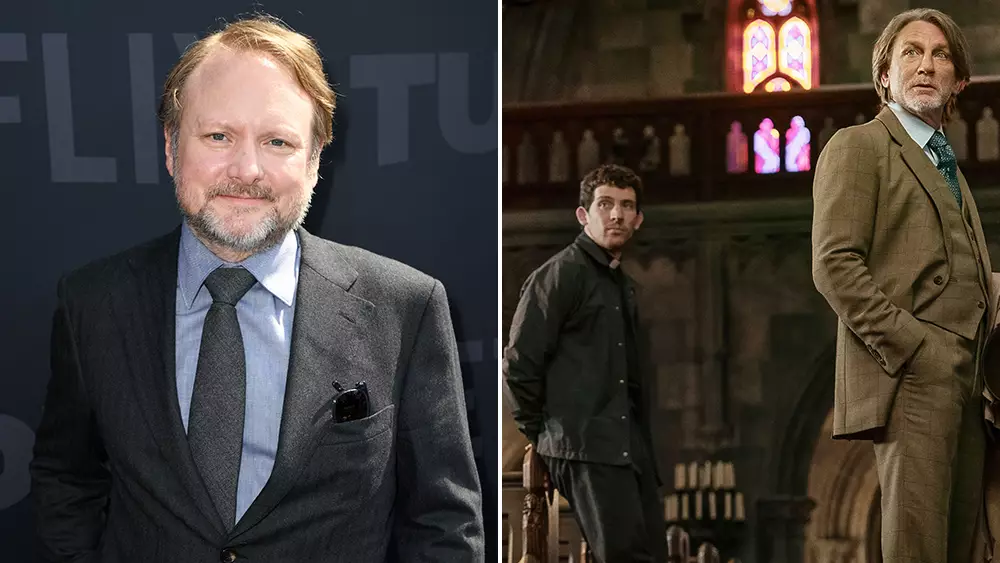In his pursuit of creative freshness, Rian Johnson’s announcement that *Wake Up Dead Man: A Knives Out Mystery* will return to a darker, gothic tone feels more like a desperate attempt at reinvention than a genuine evolution. The filmmaker’s desire to revisit the genre’s roots—drawing from Edgar Allan Poe rather than the more popular Agatha Christie—clocks as a superficial shift that promises an escape from the predictable, yet ultimately treads familiar ground. Despite his claims of experimentation, this move underscores the frustrating reality of modern mystery filmmaking: a series seemingly caught in a loop of reinvention that often rings hollow, hiding a core of creative exhaustion.
Johnson’s comments reveal an obsession with avoiding repetition, which in theory is commendable. However, the pattern of continuously changing tones—switching from the campy, lively style of *Glass Onion* to a darker, gothic atmosphere—raises questions about consistency and authentic artistic growth. Is this a genuine desire to explore new narrative landscapes, or are these tonal shifts merely superficial bandages applied to a formula that is becoming increasingly predictable? His assertion about chasing “the experience of each project” suggests a commendable desire for freshness, but it also signals a recurring tendency: rather than deepening a unique voice, these movies risk becoming a carousel of stylistic experiments that lack coherence and depth.
What’s most troubling is the acknowledgement that these films are almost like culinary experiments—trying wildly different flavors without regard for how they coalesce into a meaningful whole. Johnson speaks of “burning the ship into the sea,” which might sound poetic, but it also hints at a fundamental instability. How can a series maintain its soul if each installment is a complete departure from the last? While the filmmaker claims that these risks are what energize him, fans and critics should be wary of such reckless shifts that threaten to erode the franchise’s core identity.
The Illusion of Progress and the Franchise’s Future
Johnson’s ambivalence about continuing the series further underscores a larger problem: the reliance on genre franchises to sustain creative careers often leads to stagnation disguised as innovation. His openness to more installments, despite admitting he lacks a clear plan, signals a deeper issue within Hollywood’s approach to serialized content. Regurgitating the same format—albeit with slight tonal variations—may feel safe, but it risks turning what could be compelling reimaginings into forgettable experiments that lack purpose.
The notion of “taking a swing” each time sounds exciting on paper, but it also hints at a comfort with chaos rather than meaningful storytelling. Johnson’s fear of “knowing how to do this” suggests that these stories are less about genuine narrative exploration and more about tactically avoiding falling into the trap of predictability. Yet, how many more swings can his audience endure before boredom sets in? The art of storytelling is not merely about novelty; it’s about depth, resonance, and the ability to surprise meaningfully. So far, his approach seems more like throwing darts at a board in hopes of hitting different areas rather than crafting a cohesive vision.
Furthermore, the cast list hints at an ensemble that could have been a strength, yet there’s little evidence in the behind-the-scenes decisions that suggest these projects are about meaningful character development. They appear as mere accessories to Johnson’s tonal experiments, further emphasizing the franchise’s struggle to carve a distinctive identity beyond its stylish veneer.
The Frustration of Franchise Fatigue Amidst Artistic Hesitation
Ultimately, Johnson’s framework reveals a tension between the desire for artistic renewal and the economic realities of franchise filmmaking. While he claims to be rejuvenated with each project, his lack of a concrete future plan emphasizes a deeper uncertainty about the series’ direction. The repeated pattern of tonal shifts and genre bending may temporarily stave off boredom, but it also risks alienating audiences seeking genuine, consistent storytelling they can invest in.
In an era where Hollywood is increasingly obsessed with franchises, Johnson’s approach exposes the inherent compromises of this system. The temptation to endlessly remix familiar formulas—treating each film as a creative experiment—often comes at the expense of storytelling integrity. The problem lies not in exploring different tones but in mistaking superficial novelty for meaningful innovation. True growth in storytelling requires honest introspection and a willingness to develop characters, themes, and narratives that resonate on a deeper level—not just a series of stylistic detours.
In the end, Johnson’s bold tonal shifts reflect a broader fatigue with the genre’s conventions—yet they also highlight the fragility of creative authenticity within the franchise model. As audiences become savvier and more demanding of substance over style, it remains to be seen whether such experiments will satisfy or further dilute the franchise’s potential. If these films become merely a series of mood swings under the guise of innovation, the series risks losing its audience’s trust—preferring gimmicks over genuine storytelling.

Leave a Reply